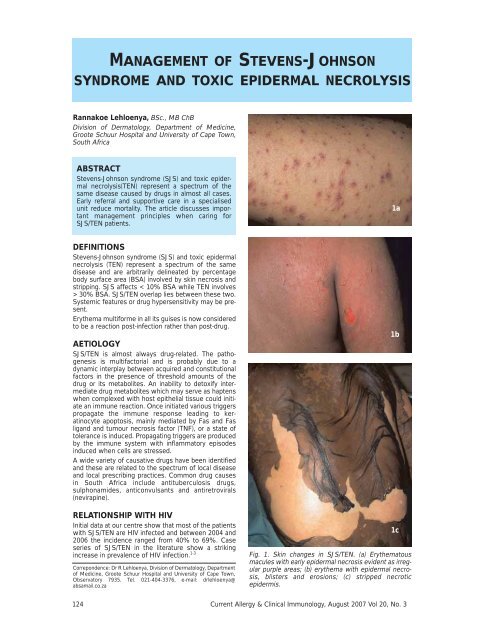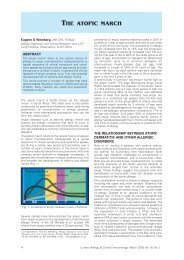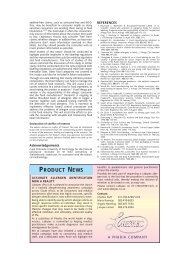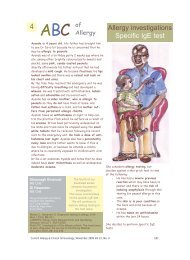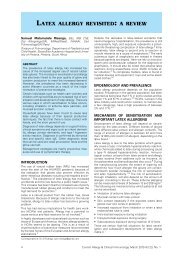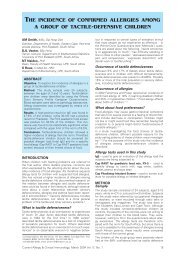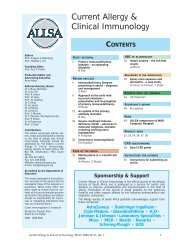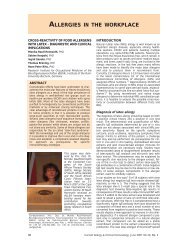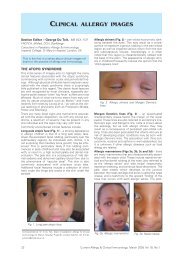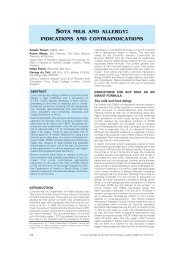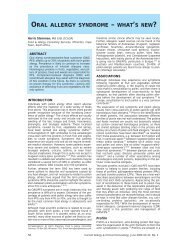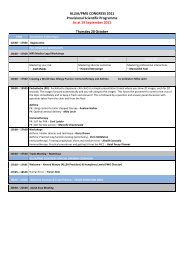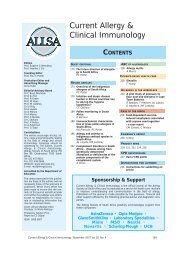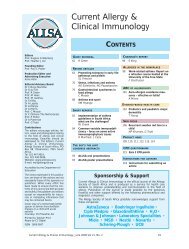Management of Stevens- Johnson syndrome and toxic epidermal
Management of Stevens- Johnson syndrome and toxic epidermal
Management of Stevens- Johnson syndrome and toxic epidermal
Create successful ePaper yourself
Turn your PDF publications into a flip-book with our unique Google optimized e-Paper software.
MANAGEMENT OF STEVENS-JOHNSON<br />
SYNDROME AND TOXIC EPIDERMAL NECROLYSIS<br />
Rannakoe Lehloenya, BSc., MB ChB<br />
Division <strong>of</strong> Dermatology, Department <strong>of</strong> Medicine,<br />
Groote Schuur Hospital <strong>and</strong> University <strong>of</strong> Cape Town,<br />
South Africa<br />
ABSTRACT<br />
<strong>Stevens</strong>-<strong>Johnson</strong> <strong>syndrome</strong> (SJS) <strong>and</strong> <strong>toxic</strong> <strong>epidermal</strong><br />
necrolysis(TEN) represent a spectrum <strong>of</strong> the<br />
same disease caused by drugs in almost all cases.<br />
Early referral <strong>and</strong> supportive care in a specialised<br />
unit reduce mortality. The article discusses important<br />
management principles when caring for<br />
SJS/TEN patients.<br />
1a<br />
DEFINITIONS<br />
<strong>Stevens</strong>-<strong>Johnson</strong> <strong>syndrome</strong> (SJS) <strong>and</strong> <strong>toxic</strong> <strong>epidermal</strong><br />
necrolysis (TEN) represent a spectrum <strong>of</strong> the same<br />
disease <strong>and</strong> are arbitrarily delineated by percentage<br />
body surface area (BSA) involved by skin necrosis <strong>and</strong><br />
stripping. SJS affects < 10% BSA while TEN involves<br />
> 30% BSA. SJS/TEN overlap lies between these two.<br />
Systemic features or drug hypersensitivity may be present.<br />
Erythema multiforme in all its guises is now considered<br />
to be a reaction post-infection rather than post-drug.<br />
AETIOLOGY<br />
SJS/TEN is almost always drug-related. The pathogenesis<br />
is multifactorial <strong>and</strong> is probably due to a<br />
dynamic interplay between acquired <strong>and</strong> constitutional<br />
factors in the presence <strong>of</strong> threshold amounts <strong>of</strong> the<br />
drug or its metabolites. An inability to detoxify intermediate<br />
drug metabolites which may serve as haptens<br />
when complexed with host epithelial tissue could initiate<br />
an immune reaction. Once initiated various triggers<br />
propagate the immune response leading to keratinocyte<br />
apoptosis, mainly mediated by Fas <strong>and</strong> Fas<br />
lig<strong>and</strong> <strong>and</strong> tumour necrosis factor (TNF), or a state <strong>of</strong><br />
tolerance is induced. Propagating triggers are produced<br />
by the immune system with inflammatory episodes<br />
induced when cells are stressed.<br />
A wide variety <strong>of</strong> causative drugs have been identified<br />
<strong>and</strong> these are related to the spectrum <strong>of</strong> local disease<br />
<strong>and</strong> local prescribing practices. Common drug causes<br />
in South Africa include antituberculosis drugs,<br />
sulphonamides, anticonvulsants <strong>and</strong> antiretrovirals<br />
(nevirapine).<br />
RELATIONSHIP WITH HIV<br />
Initial data at our centre show that most <strong>of</strong> the patients<br />
with SJS/TEN are HIV infected <strong>and</strong> between 2004 <strong>and</strong><br />
2006 the incidence ranged from 40% to 69%. Case<br />
series <strong>of</strong> SJS/TEN in the literature show a striking<br />
increase in prevalence <strong>of</strong> HIV infection. 1-3<br />
Correpondence: Dr R Lehloenya, Division <strong>of</strong> Dermatology, Department<br />
<strong>of</strong> Medicine, Groote Schuur Hospital <strong>and</strong> University <strong>of</strong> Cape Town,<br />
Observatory 7935. Tel. 021-404-3376, e-mail: drlehloenya@<br />
absamail.co.za<br />
1b<br />
Fig. 1. Skin changes in SJS/TEN. (a) Erythematous<br />
macules with early <strong>epidermal</strong> necrosis evident as irregular<br />
purple areas; (b) erythema with <strong>epidermal</strong> necrosis,<br />
blisters <strong>and</strong> erosions; (c) stripped necrotic<br />
epidermis.<br />
1c<br />
124 Current Allergy & Clinical Immunology, August 2007 Vol 20, No. 3
Some studies show a direct relationship between the<br />
incidence <strong>of</strong> SJS/TEN <strong>and</strong> HIV infection with HIV-infected<br />
persons more likely to develop SJS/TEN. 4-6<br />
CLINICAL FEATURES<br />
SJS/TEN is a serious condition with reported mortality<br />
rates in the literature ranging between 10% <strong>and</strong> 75%.<br />
The patient may present with a prodromal phase <strong>of</strong><br />
fever, malaise, cough, stinging eyes <strong>and</strong> sore throat, for<br />
which the patient <strong>of</strong>ten consults a doctor <strong>and</strong> is treated<br />
for an upper respiratory tract infection. This is followed,<br />
1-3 days later, by a red, measles-like rash which progresses<br />
to a dusky purple/red colour with blistering <strong>and</strong><br />
<strong>epidermal</strong> detachment (Figs 1a -1c).<br />
Palms <strong>and</strong> soles are <strong>of</strong>ten involved early with erythema,<br />
pain <strong>and</strong> blisters (Figs 2a & 2b). At least one <strong>of</strong> the<br />
mucosal surfaces is eroded. The eyes, oropharynx (Fig.<br />
3) <strong>and</strong> genitalia are involved in > 90% <strong>of</strong> patients. The<br />
respiratory system can be extensively involved. The<br />
skin <strong>and</strong> mucosal lesions are painful. Leucopenia,<br />
eosinophilia <strong>and</strong> abnormal liver enzymes have been<br />
reported 7 <strong>and</strong> some patients may show prerenal impairment<br />
due to reduced fluid intake in relation to their<br />
increased overall fluid needs.<br />
The course <strong>of</strong> the disease is unpredictable <strong>and</strong> at presentation<br />
it is impossible to predict the final severity<br />
<strong>and</strong> extent <strong>of</strong> the disease; therefore it is important to<br />
monitor these patients until the evolution is complete.<br />
PROGNOSTIC FACTORS<br />
Seven parameters have been identified as risk factors<br />
<strong>and</strong> incorporated into a disease severity score called<br />
SCORTEN which predicts mortality. 8 These are:<br />
Fig. 3. Mucosal changes in SJS/TEN. Haemorraghic<br />
eroded mucosa <strong>and</strong> peri-or<strong>of</strong>icial skin.<br />
• Age over 40 years<br />
• Malignancy<br />
• Tachycardia (pulse > 120/minute)<br />
• Initial <strong>epidermal</strong> detachment <strong>of</strong> > 10%<br />
• Serum urea level > 10 mmol/l<br />
• Serum glucose level > 14 mmol/l<br />
• Bicarbonate level > 20 mmol/l<br />
Other comorbidities can <strong>of</strong>ten be the cause <strong>of</strong> higher<br />
mortality rates <strong>and</strong> have an additive effect to the abovementioned<br />
factors.<br />
MANAGEMENT<br />
Early diagnosis<br />
Early diagnosis has been shown to reduce mortality<br />
rates.<br />
2a<br />
Ascribing causality<br />
A level <strong>of</strong> probability for the association between the<br />
clinical picture <strong>and</strong> the drug requires a risk evaluation <strong>of</strong><br />
the identified drugs for causing SJS/TEN. This should<br />
incorporate an assessment <strong>of</strong> the temporal relationship<br />
between the use <strong>of</strong> the drug <strong>and</strong> the occurrence <strong>of</strong> the<br />
reaction, including responses to drug withdrawal. 9 This<br />
is where a good history becomes important. The<br />
enquiry should include herbal medication, ‘natural products’,<br />
once-<strong>of</strong>f medication, medication obtained from<br />
friends, etc.<br />
Early withdrawal<br />
Early withdrawal <strong>of</strong> the <strong>of</strong>fending drug improves outcome.<br />
This is more effective for drugs with shorter halflives<br />
but it seems to be less important for drugs with<br />
longer half-lives. 10<br />
2b<br />
Fig. 2. Palmoplantar changes in SJS/TEN. (a) Painful<br />
erythema with early <strong>epidermal</strong> necrosis (purple areas)<br />
<strong>of</strong> the sole; (b) painful necrotic soles with secondary<br />
blistering. Similar changes occur on the palms.<br />
Early transfer<br />
Early transfer to <strong>and</strong> management in a specialised unit<br />
improves outcome. This improvement has been attributed<br />
to proper nutrition, avoidance <strong>of</strong> antibiotics <strong>and</strong><br />
corticosteroids, <strong>and</strong> implementation <strong>of</strong> clearly defined<br />
wound management procedures. 11<br />
Good nursing <strong>and</strong> supportive care<br />
This is the mainstay <strong>of</strong> treatment for these patients <strong>and</strong><br />
specific therapies play less <strong>of</strong> a role in the overall management.<br />
Current Allergy & Clinical Immunology, August 2007 Vol 20, No. 3 125
Multidisciplinary approach<br />
SJS/TEN is a systemic disorder <strong>and</strong> it can involve many<br />
organs. For this reason, a team approach which<br />
includes dermatologists, burns unit specialists, ICU<br />
specialists, nutritionists, ophthalmologists, microbiologists,<br />
infectious disease specialists, general physicians<br />
<strong>and</strong> a pain management team centered around a good<br />
core <strong>of</strong> experienced nurses assures optimal management.<br />
Adequate nutrition<br />
Nutrition is an integral part <strong>of</strong> management as SJS/TEN<br />
is a hypermetabolic state <strong>and</strong> there are increased energy<br />
<strong>and</strong> protein dietary requirements which are proportional<br />
to the BSA affected.<br />
Oral intake is <strong>of</strong>ten difficult because <strong>of</strong> upper gastrointestinal<br />
tract (GIT) injury; therefore diet <strong>and</strong> fluid modification<br />
are important. Early in the disease when the<br />
dysphagia <strong>and</strong> odynophagia are severe, a fluid diet is<br />
preferable <strong>and</strong> more tolerable for the patient. Factors to<br />
consider with regard to oral feeds are temperature,<br />
acidity (hot, cold <strong>and</strong> acidic food <strong>and</strong> beverages worsen<br />
pain), texture <strong>and</strong> moisture <strong>of</strong> food as smooth, moist<br />
food is more tolerable than rough, abrasive food.<br />
If nutritional requirements exceed the ability to eat then<br />
there is a role for enteral feeding, 11 but it is important<br />
to encourage oral feeds to avoid adhesions in the upper<br />
GIT.<br />
Glycaemic control can be a problem as a result <strong>of</strong><br />
stress <strong>and</strong> previous treatment with systemic steroids.<br />
As hyperglycaemia is one <strong>of</strong> the risk factors for poor<br />
outcome, close control <strong>of</strong> blood glucose should be<br />
maintained.<br />
Skin care<br />
Careful protection <strong>of</strong> the exposed dermis <strong>and</strong> early reepithelialising<br />
skin is paramount to prevent further<br />
detachment. Unbroken epidermis, even if dead, serves<br />
as protection for underlying viable <strong>and</strong> regenerating tissue.<br />
Daily baths (Fig. 4) <strong>and</strong> the use <strong>of</strong> clean, sterile,<br />
non-adhesive dressings (Fig. 5) as required are routine.<br />
It is important to observe the skin closely during<br />
bathing, noting infected areas from which swabs<br />
should be taken. These are important for early empirical<br />
antibiotic therapy if the wounds become septic<br />
while blood cultures are outst<strong>and</strong>ing.<br />
Pain management<br />
Pain control is an integral part <strong>of</strong> the management <strong>of</strong><br />
SJS/TEN but there is not much literature available to<br />
guide one except for burn pain management. SJS/TEN<br />
patients experience background pain which is present<br />
at rest <strong>and</strong> is <strong>of</strong> low intensity. During procedures the<br />
pain is more intense <strong>and</strong> short-lived <strong>and</strong> the latter is<br />
referred to as procedural pain. <strong>Management</strong> <strong>of</strong> pain has<br />
to cater for both types. It has been shown that burn<br />
patients tend to be undertreated for pain <strong>and</strong> it would<br />
not be presumptuous to assume the same for<br />
SJS/TEN.<br />
Pain management has to be individualised, taking into<br />
consideration the clinical needs <strong>of</strong> the patient, viable<br />
route <strong>of</strong> administration, risk <strong>of</strong> respiratory suppression<br />
<strong>and</strong> monitoring facilities. In a non-ICU setting full consciousness<br />
is preferable as is oral therapy for reasons<br />
already mentioned. Oral transmucosal, short-acting,<br />
medium-potency opioids are best for procedural pain.<br />
Anxiolytics such as low-dose benzodiazepines can be<br />
added <strong>and</strong> these are more effective for patients with<br />
high pre-procedure anxiety <strong>and</strong> high baseline pain<br />
Fig. 4. Care <strong>of</strong> the skin in SJS/TEN. Daily baths.<br />
Fig. 5. Care <strong>of</strong> the skin in SJS/TEN. Non-adherent, sterile<br />
dressings.<br />
scores. Longer-acting, mild- to moderate-potency opioids<br />
together with paracetamol should be given for<br />
background pain. 12<br />
Monitoring<br />
Frequent monitoring <strong>of</strong> vital signs is a vital part <strong>of</strong> management<br />
as they <strong>of</strong>fer the first signs <strong>of</strong> a worsening<br />
systemic condition. The earliest signs <strong>of</strong> sepsis are<br />
hypothermia, tachycardia, hypotension, confusion <strong>and</strong><br />
diarrhoea. These require prompt intervention.<br />
Role <strong>of</strong> surgical debridement<br />
This is not recommended in most centres.<br />
Temperature control<br />
With the loss <strong>of</strong> the integument patients with SJS/TEN<br />
have impaired temperature control <strong>and</strong> are best nursed<br />
in rooms with ambient temperature <strong>and</strong> humidity.<br />
Fluid balance<br />
Careful monitoring <strong>of</strong> fluid balance with strict input <strong>and</strong><br />
output charts is essential because the patients have<br />
significant insensible fluid loss <strong>and</strong> <strong>of</strong>ten present with<br />
dehydration <strong>and</strong> renal impairment. This needs to be<br />
aggressively corrected as it is one <strong>of</strong> the risk factors for<br />
a poor outcome.<br />
126 Current Allergy & Clinical Immunology, August 2007 Vol 20, No. 3
Role <strong>of</strong> prophylactic antibiotics<br />
Most clinicians agree that these are best left for proven<br />
infections. Careful monitoring for any signs <strong>of</strong> infection<br />
is critical to facilitate prompt sepsis intervention.<br />
Intravenous lines<br />
These can be a source <strong>of</strong> sepsis in patients with<br />
stripped skin. If the patient is taking sufficient oral fluids<br />
then they are not indicated. Specific indications<br />
include a confirmed infection needing parenteral antibiotics<br />
or resuscitation.<br />
Eye care<br />
The most common problem is conjunctival involvement.<br />
This can be mild but may be severe leading to<br />
scarring <strong>and</strong> its complications which include blinding<br />
keratopathy <strong>and</strong> limbal stem cell deficiency.<br />
General supportive care with 1-2-hourly lubrication <strong>and</strong><br />
early assessment by an ophthalmologist to prevent or<br />
manage these complications is indicated. There is a<br />
role for contact lens use to prevent synechiae or bluntinstrument<br />
release <strong>of</strong> developing synechiae. B<strong>and</strong>age<br />
contact lenses for non-healing corneal ulcers <strong>and</strong> amniotic<br />
membrane transplantation for severe persistent<br />
corneal damage may be necessary. 13 Up to 79% <strong>of</strong><br />
patients with eye involvement in the acute stage <strong>of</strong><br />
SJS/TEN have long-term eye problems such as xerophthalmia,<br />
ectropion, entropion, symblepharon, corneal<br />
opacity <strong>and</strong> pannus formation. 14,15 <strong>Management</strong> should<br />
aim to keep these disabilities to a minimum.<br />
Genital care<br />
Good hygiene <strong>and</strong> the use <strong>of</strong> non-adhesive dressings<br />
are usually adequate to allow healing <strong>of</strong> mucosal erosions.<br />
Every effort should be made to prevent adhesions<br />
in areas where two eroded surfaces are opposed.<br />
This is especially important in uncircumcised men as<br />
phimosis may complicate management.<br />
Indwelling urinary catheters should be avoided, if possible,<br />
as they can be a source <strong>of</strong> sepsis in patients with<br />
little skin-barrier protection. They may be essential<br />
however if nursing care is compromised by constant<br />
soiling.<br />
Upper GIT care<br />
Continuous <strong>and</strong> frequent oral intake should be encouraged<br />
as this helps to maintain a patent system <strong>and</strong> prevent<br />
adhesions. Mild, medicated mouthwash should be<br />
used 2-hourly to clean the mouth. A lubricating cream<br />
can be used to s<strong>of</strong>ten haemorrhagic lip crusts prior to<br />
removal. Paraffin gauze dressings <strong>and</strong> lubricating<br />
cream are used to cover erosions <strong>and</strong> avoid fissuring.<br />
An antifungal therapy should be used if oral thrush<br />
develops. Lip <strong>and</strong> mouth lesions tend to persist after<br />
other areas have re-epithelialised.<br />
Respiratory system (RS)<br />
Some authors report RS involvement to be common,<br />
with 10-20% needing artificial ventilation. 16 In our experience<br />
RS involvement is usually mild <strong>and</strong> very few<br />
patients ever need ventilatory support. They can present<br />
with tracheobronchial mucosal necrosis, pulmonary<br />
oedema, adult respiratory distress <strong>syndrome</strong><br />
<strong>and</strong> infectious pneumonia or pneumonitis. Pooling <strong>of</strong><br />
saliva <strong>and</strong> secretions may predispose to aspiration <strong>and</strong><br />
therefore these need to be cleared frequently.<br />
Coughing may be difficult, posing a further risk <strong>of</strong> RS<br />
infection.<br />
Specific management<br />
Systemic steroids<br />
There is controversy regarding use <strong>of</strong> systemic<br />
steroids 7,13 but evidence suggests that at most they are<br />
not beneficial <strong>and</strong> at worst can be harmful to the<br />
patient if used in large doses. For patients in septic<br />
shock, treatment with low doses <strong>of</strong> hydrocortisone<br />
may have better outcome but this has not yet been<br />
shown in those with associated SJS/TEN. 17<br />
Intravenous immunoglobulin (IVIG)<br />
IVIG blocks Fas/Fas lig<strong>and</strong> interaction, preventing progression<br />
<strong>of</strong> keratinocyte apoptosis. 7 If used early in<br />
SJS/TEN it may halt progression <strong>of</strong> the disease.<br />
French 18 reviewed 9 prospective <strong>and</strong> retrospective<br />
uncontrolled studies, containing more than 10 patients<br />
each, in which patients with SJS/TEN were treated<br />
with IVIG. He concluded that at doses <strong>of</strong> > 2 mg/kg it<br />
is safe <strong>and</strong> decreases mortality rates. Mittman et al. 19,20<br />
came to the same conclusion. As one cannot predict<br />
prognosis in SJS/TEN its true benefit on mortality is not<br />
clear. The cost to benefit ratio is the main factor that<br />
restricts its use outside <strong>of</strong> developed countries.<br />
Cyclosporine<br />
Chave et al. 7 reviewed 10 papers which included a total<br />
<strong>of</strong> 20 patients treated with cyclosporine. They concluded<br />
that, if given early in the disease, at 3-5 mg/kg daily,<br />
either intravenously or orally, over 2 weeks, it arrested<br />
progression <strong>of</strong> disease without any increased risk <strong>of</strong><br />
sepsis.<br />
Plasmapheresis <strong>and</strong> haemodialysis<br />
These have been advocated by some authors to<br />
remove drug metabolites <strong>and</strong> responsible cytokines<br />
from circulation 7,21 but both are <strong>of</strong> questionable<br />
value. 15,22<br />
MedicAlert<br />
It is a critical <strong>and</strong> <strong>of</strong>ten neglected part <strong>of</strong> the management<br />
<strong>of</strong> these patients to prevent a recurrence <strong>of</strong> this<br />
potentially life-threatening condition. It is the responsibility<br />
<strong>of</strong> the attending doctor to at least facilitate this<br />
process.<br />
Rechallenging<br />
Most authors recommend that SJS/TEN patients<br />
should never be rechallenged. There is a strong association<br />
between SJS/TEN <strong>and</strong> the drugs used to manage<br />
the rampant HIV epidemic <strong>and</strong> concomitant upsurge <strong>of</strong><br />
tuberculosis (TB). 9 Because <strong>of</strong> the limited arsenal <strong>of</strong><br />
effective drugs available to clinicians for treatment,<br />
especially for TB, it is <strong>of</strong>ten necessary to rechallenge<br />
patients.<br />
There are currently no good studies to guide a clinician<br />
on how to reintroduce the drugs but the general principles<br />
<strong>of</strong> rechallenging are applicable. Because <strong>of</strong> the<br />
high-risk nature <strong>of</strong> the reintroduction a few basic conditions<br />
have to be met. 9<br />
• It has to be done in hospital under careful supervision<br />
by someone with experience in the management <strong>of</strong><br />
adverse drug reactions <strong>and</strong> rechallenges.<br />
• The patient’s baseline parameters have to be as<br />
close to the pre-morbid state as possible.<br />
• The sequence in which the individual drugs are introduced<br />
depends on the known likelihood <strong>of</strong> the drug<br />
to induce SJS/TEN. The drug most likely to have<br />
Current Allergy & Clinical Immunology, August 2007 Vol 20, No. 3 127
caused the reaction is introduced last, if at all. If all<br />
the other drugs are re-introduced successfully, bar<br />
this suspected culprit drug then the assumption can<br />
be made that it caused the reaction <strong>and</strong> the patient<br />
does not need to be rechallenged with it.<br />
• The drugs are introduced sequentially <strong>and</strong> additively.<br />
They can be started in small doses which are<br />
increased over 3-4 days until normal therapeutic<br />
doses are attained. It has to be stressed that this<br />
incremental dosing is not a desensitisation regimen,<br />
but is based on a theory that the total dose <strong>of</strong> the<br />
drug ingested affects the extent <strong>of</strong> the disease.<br />
There is no evidence at this stage to support this<br />
approach or any other for that matter.<br />
• Monitoring is critical to detect any reaction early. The<br />
parameters that are monitored are the patient’s subjective<br />
feelings <strong>of</strong> being unwell. These can include a<br />
sore throat, itchy or burning eyes, itchy skin <strong>and</strong><br />
fever. Objective changes <strong>of</strong> the skin <strong>and</strong> mucosa may<br />
lag behind as do abnormal laboratory blood parameters.<br />
• If signs <strong>of</strong> any reaction are noted then the most<br />
recently introduced drug is stopped immediately <strong>and</strong><br />
the patient is monitored closely. This drug is not reintroduced<br />
again. Further alternative drug re-introduction<br />
is only resumed once the patient has reached<br />
baseline parameters again.<br />
• For tuberculosis rechallenge, the patient must be<br />
started on two antituberculosis drugs to which they<br />
have not previously been exposed plus the first drug<br />
<strong>of</strong> the rechallenge regimen. This is to avoid the development<br />
<strong>of</strong> resistance. Delay in getting the patient to<br />
a full complement <strong>of</strong> drugs increases the risk <strong>of</strong><br />
developing resistance.<br />
SUMMARY<br />
SJS <strong>and</strong> TEN are life-threatening conditions increasingly<br />
being seen as a result <strong>of</strong> the HIV p<strong>and</strong>emic.<br />
<strong>Management</strong> entails early identification <strong>and</strong> withdrawal<br />
<strong>of</strong> the <strong>of</strong>fending drug or possible drug(s), transfer to<br />
a specialised centre <strong>and</strong> supportive care employing a<br />
multidisciplinary approach. If there is a need for re-introduction<br />
<strong>of</strong> any <strong>of</strong> the possible medications, it has to be<br />
done by experienced clinicians in a hospital setting.<br />
Declaration <strong>of</strong> conflict <strong>of</strong> interest<br />
The author declares no conflict <strong>of</strong> interst.<br />
REFERENCES<br />
1. Mockenhaupt M, Rzany B. The epidemiology <strong>of</strong> serious cutaneous<br />
drug reaction. In: Williams HC, ed. The Challenge <strong>of</strong> Dermato-<br />
Epidemiology. Boca Raton/New York: CRC Press, 1997: 329-342.<br />
2. Pitche P, Padonou CS, Kombate K, et al. <strong>Stevens</strong>-<strong>Johnson</strong> <strong>syndrome</strong><br />
<strong>and</strong> <strong>toxic</strong> <strong>epidermal</strong> necrolysis in Lome (Togo). Evolutional<br />
<strong>and</strong> etiological pr<strong>of</strong>iles <strong>of</strong> 40 cases. Ann Dermatol Venereol 2005;<br />
132: 531-534.<br />
3. Correia O, Chosidow O, Saiag P, et al. Evolving pattern <strong>of</strong> druginduced<br />
<strong>toxic</strong> <strong>epidermal</strong> necrolysis. Dermatology 1993; 186: 32-37.<br />
4. Nunn P, Gicheha C, Hayes R, et al. Cross-sectional survey <strong>of</strong> HIV<br />
infection among patients with tuberculosis in Nairobi, Kenya.<br />
Tuberc Lung Dis 1992; 73: 45-51.<br />
5. Nunn P, Kibuga D, Gathua S, et al. Cutaneous hypersensitivity reactions<br />
due to thiacetazone in HIV-1 seropositive patients treated for<br />
tuberculosis. Lancet 1991; 337: 627-630.<br />
6. Chintu C, Luo C, Bhat G, et al. Cutaneous hypersensitivity reactions<br />
due to thiacetazone in the treatment <strong>of</strong> tuberculosis in Zambian<br />
children infected with HIV-1. Arch Dis Child 1993; 68: 665-668.<br />
7. Chave TA, Mortimer NJ, Sladden MJ, et al. Toxic <strong>epidermal</strong> necrolysis:<br />
current evidence, practical management <strong>and</strong> future directions.<br />
Br J Dermatol 2005; 153: 241-253.<br />
8. Bastuji-Garin S, Fouchard N, Bertocchi M, et al. SCORTEN: a severity-<strong>of</strong>-illness<br />
score for <strong>toxic</strong> <strong>epidermal</strong> necrolysis. J Invest Dermatol<br />
2000; 115: 149-153.<br />
9. Todd G. Adverse cutaneous drug eruptions <strong>and</strong> HIV: a clinician’s<br />
global perspective. Dermatol Clin 2006; 24: 459-472.<br />
10. Garcia-Doval I, LeCleach L, Bocquet H, et al. Toxic <strong>epidermal</strong><br />
necrolysis <strong>and</strong> <strong>Stevens</strong>-<strong>Johnson</strong> <strong>syndrome</strong>: does early withdrawal<br />
<strong>of</strong> causative drugs decrease the risk <strong>of</strong> death Arch Dermatol 2000;<br />
136: 323-327.<br />
11. Clayton NA, Kennedy PJ. <strong>Management</strong> <strong>of</strong> dysphagia in <strong>toxic</strong> <strong>epidermal</strong><br />
necrolysis (TEN) <strong>and</strong> <strong>Stevens</strong>-<strong>Johnson</strong> <strong>syndrome</strong> (SJS).<br />
Dysphagia 2007; 22: 187-192.<br />
12. Patterson DR, H<strong>of</strong>l<strong>and</strong> HW, Espey K, et al. Pain management.<br />
Burns 2004; 30: A10-A15.<br />
13. Hynes AY, Kafkala C, Daoud YJ, et al. Controversy in the use <strong>of</strong><br />
high-dose systemic steroids in the acute care <strong>of</strong> patients with<br />
<strong>Stevens</strong>-<strong>Johnson</strong> <strong>syndrome</strong>. Int Ophthalmol Clin 2005; 45: 25-48.<br />
14. Oplatek A, Brown K, Sen S, et al. Long-term follow-up <strong>of</strong> patients<br />
treated for <strong>toxic</strong> <strong>epidermal</strong> necrolysis. J Burn Care Res 2006; 27:<br />
26-33.<br />
15. Sehgal VN. Srivastava G. Toxic <strong>epidermal</strong> necrolysis (TEN) Lyell’s<br />
<strong>syndrome</strong>. J Dermatol Treat 2005; 16: 278-286.<br />
16. Kamada N, Kinoshita K, Togawa Y, et al. Chronic pulmonary complications<br />
associated with <strong>toxic</strong> <strong>epidermal</strong> necrolysis: Report <strong>of</strong> a<br />
severe case with anti-Ro/SS-A <strong>and</strong> a review <strong>of</strong> the published work.<br />
J Dermatol 2006; 33: 616-622.<br />
17. Oppert M, Schindler R, Husung C, et al. Low dose hydrocortisone<br />
improves shock reversal <strong>and</strong> reduces cytokine levels in early hyperdynamic<br />
septic shock. Crit Care Med 2005; 33: 2457-2464.<br />
18. French LE. Toxic <strong>epidermal</strong> necrolysis <strong>and</strong> <strong>Stevens</strong>-<strong>Johnson</strong> <strong>syndrome</strong>:<br />
Our current underst<strong>and</strong>ing. Allergol Int 2006; 55: 9-16.<br />
19. Mittman N, Chan BC, Knowles S, Shear NH. IVIG for the treatment<br />
<strong>of</strong> <strong>toxic</strong> <strong>epidermal</strong> necrolysis. Skin Therapy Letter.com 2007; 12:<br />
7-9.<br />
20. Mittman N, Chan B, Knowles S, et al. Intravenous immunoglobulin<br />
use in patients with <strong>toxic</strong> <strong>epidermal</strong> necrolysis <strong>and</strong> <strong>Stevens</strong>-<br />
<strong>Johnson</strong> <strong>syndrome</strong>. Am J Clin Dermatol 2006; 7: 359-368.<br />
21. Egan CA, Grant WJ, Morris SE, et al. Plasmapharesis as an adjunct<br />
treatment in <strong>toxic</strong> <strong>epidermal</strong> necrolysis. J Am Acad Dermatol 1999;<br />
40: 458-461.<br />
22. Furubacke A, Berlin G, Anderson C, Sjorberg F. Lack <strong>of</strong> significant<br />
treatment effect <strong>of</strong> plasma exchange in the treatment <strong>of</strong> druginduced<br />
<strong>toxic</strong> <strong>epidermal</strong> necrolysis. Intensive Care Med 1999; 25:<br />
1307-1310.<br />
128 Current Allergy & Clinical Immunology, August 2007 Vol 20, No. 3


